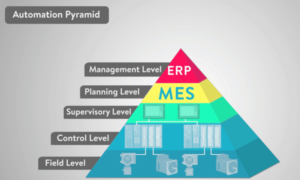What comes to mind when you hear the phrase “automation in manufacturing”? Some people picture robot arms replacing dangerous or repetitive human tasks. Others think of software connecting all the shop floor machinery.
Or maybe your mind goes to an ERP solution like Jobman that plays a crucial role in managing all the moving parts of your business?
Automation in manufacturing is all of that and more.
Automation could be the key to growing domestic productivity by 50% to 150% by 2030. And it’s already here.
Technology already touches every part of your business. From the smallest sensor to top-level management decisions, linking those layers can increase productivity and profits while protecting workers.
That’s where the 5-layer automation pyramid comes into play.
What is the automation pyramid?
Manufacturing is a complex business. The 5-layer automation pyramid is a handy visual guide to understanding how the technology operating at every level of your business work together for wide-ranging benefits.
The 5 layers, from top to bottom, are:

Let’s build the pyramid by looking at each layer in detail. Fair warning, there are a lot of acronyms in this blog!
Layer 5: Automation on the shop floor (the field level)
Automation in manufacturing starts with the machinery itself. Think about all those moving parts that respond to inputs and perform a relatively simple function:
- Sensors
- Actuators
- Motors
- Switches
- Gauges
- Alarms
- Release Valves
These devices communicate with the next level up through communication protocols, which allow the control level to interpret what the devices ‘see’ and make decisions.
Layer 4: The control level
The control level:
- Receives input from the sensors
- Computes the data
- Adjusts, fires, shuts off, increases (etc.) whatever the machine is doing
- Translates all that instant action into human language
A sensor ‘sees’ when something is wrong with the material in your production line. But it’s the Programmable Logic Controller (PLC) that decides what action to take. This process often involves a Proportional Integral Derivative (PID), a computational feedback loop looking for errors based on an ideal set value.
Layer 3: Human-machine interaction (The Supervisory Level)
Here is where you’ll encounter SCADA systems, or Supervisory Control and Data Acquisition. SCADA stores high volumes of data from the control level and turns the information into a graphical interface so a human can make decisions – or understand the decisions SCADA is making.
Scale the control level up to multiple machines and several sites, and you get the idea of SCADA. You probably interact with a similar system every day:
- Productivity dashboard
- Machine error reporting
- Remote machine control
- Fault detection
- Preventative maintenance systems
LAYER 2: Planning
Sitting over all those SCADA smarts is a planning level. In manufacturing, this layer looks at your entire production line from raw material input to finished product. Often called a Management Execution System (MES).
- Material yield
- Wastage
- Employee hours
- Finished product figures
- Real costs
The Planning Layer allows management to make decisions based on actual production data.
But is that enough to run a competitive business? All that data is great; however, without an ERP system like Jobman working for you, it’s hard to make truly informed decisions.
Layer 1: Management and ERP
At the top of the manufacturing automation pyramid is your Enterprise Resource Planning (ERP) system.
ERP software integrates across your entire business. From the shop floor to finance, quotes and invoices to real-time job tracking, a made-for-manufacturing ERP utilises all the layers below and brings in data from other sources.
ERPs provide transparency across the manufacturing lifecycle. They enable management decisions and sales activity. They track your business from the ground up, with benefits for productivity, profits and customer relationships.
Automation in Australian manufacturing: Are we missing an opportunity?
McKinsey & Company recently estimated that automation could put between $4,000 and $15,000 more in the average Aussie’s pocket.
Protecting local businesses, upskilling our workforce and rekindling the Australian economy means embracing automation in manufacturing. The good news is it’s easier than you might think.
Contact the Jobman team to see how our manufacturing ERP integrates with your operation to deliver productivity and business growth.




